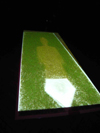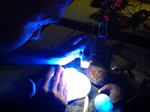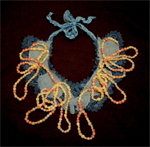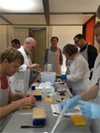 |
|
 |
|
 |
|
 |
|
 |
|
 |
|
 |
|
 |
|
 |
|
 |
|
 |
|
 |
|
 |
|
 |
|
 |
|
 |
|
 |
|
 |
|
 |
|
 |
|
Site Archive (1997-2020) - Depuis 2021 le nouveau site est / Since 2021 the new website is ICI/HERE »»» |

 TRUST ME, I'M AN ARTIST > ARTICLES BY THE ARTISTS & CURATORS TRUST ME, I'M AN ARTIST > ARTICLES BY THE ARTISTS & CURATORS
|
|
|
|
Articles by the Artists & Curators of the "Trust Me, I'm An Artist" project
All articles are downloadable Pdf when you click on "more".
- Trust Me, I'm An Artist, by Bobbie Farsides, Anna Dumitriu and Annick Bureaud
 "Trust Me, I'm An Artist / TMIAAA" is a European-based project devoted to developing "Ethical Frameworks for Artists, Cultural Institutions and Audiences Engaged in the Challenges of Creating and Experiencing New Art Forms in Biotechnology and Biomedicine". As such it brings together a wide variety of interested parties to debate, and hopefully to some extent resolve, ethical issues arising at the intersection of art, science and biomedicine. This article presents the project, its methodology and some of the issues we are targetting. (more)
"Trust Me, I'm An Artist / TMIAAA" is a European-based project devoted to developing "Ethical Frameworks for Artists, Cultural Institutions and Audiences Engaged in the Challenges of Creating and Experiencing New Art Forms in Biotechnology and Biomedicine". As such it brings together a wide variety of interested parties to debate, and hopefully to some extent resolve, ethical issues arising at the intersection of art, science and biomedicine. This article presents the project, its methodology and some of the issues we are targetting. (more)
|
|
- Flesh-Eaters: Notes towards a Zombie Methodology, by Martin O'Brien
 In this article Martin O'Brien discusses the ethics of witnessing the sick body in performance. The article considers the concept of dis-ease as a mode of spectatorship. It is a concept employed in order to think through the politics of witnessing difficult performance work by artists with illnesses. He particularly reflects upon the nature of participation within his performance, which involved explicit interaction with his boy as sick.
In this article Martin O'Brien discusses the ethics of witnessing the sick body in performance. The article considers the concept of dis-ease as a mode of spectatorship. It is a concept employed in order to think through the politics of witnessing difficult performance work by artists with illnesses. He particularly reflects upon the nature of participation within his performance, which involved explicit interaction with his boy as sick.
O'Brien ends by considering the ways in which the nature of this interaction allows for the striving towards agency over ones own flesh. (more)
|
|
- On Curating Pain: The Sick Body in Martin O'Brien's 'Taste of Flesh / Bite Me I'M Yours', by Jareh Das
 This article discusses the sick body in performance art and ethics, in "Taste of Flesh/Bite Me I'm Yours", 2015 by London-based artist, Martin O'Brien.
This article discusses the sick body in performance art and ethics, in "Taste of Flesh/Bite Me I'm Yours", 2015 by London-based artist, Martin O'Brien.
It considers the bodily categorisation 'sick', particularly in relation to when the markers for such categorisation are rendered invisible through illnesses, in this context, Cystic Fibrosis. Through performing this illness, important ethical questions are raised for the performing 'sick' body, which include complicity, subjectivity and the situation-behaviour dynamics present between a performer and an audience. (more)
|
|
- Trust Me I'm An Artist: The Conundrum of Plant Life, by Spela Petrič
 "Skotopoiesis" is the first event from the series "Confronting Vegetal Otherness" within which artist Spela Petrič explores novel plant-human relationships beyond the limits of empathy, interfaces and language. This 19-hour performance was an attempt at intercognition with germinating cress, using her body's shadow as a sign of human presence. This work challenges the ethics of including plant life in artworks as well as to assess our attitude towards plants in general. (more)
"Skotopoiesis" is the first event from the series "Confronting Vegetal Otherness" within which artist Spela Petrič explores novel plant-human relationships beyond the limits of empathy, interfaces and language. This 19-hour performance was an attempt at intercognition with germinating cress, using her body's shadow as a sign of human presence. This work challenges the ethics of including plant life in artworks as well as to assess our attitude towards plants in general. (more)
|
|
- Ivor Diosi's "Molding the Signifier": An All-Too-Human Victor, by Ondřej Cakl
 In this article, curator Ondřej Cakl discusses the biocybernetic work "Molding the Signifier" by Ivor Diosi.
In this article, curator Ondřej Cakl discusses the biocybernetic work "Molding the Signifier" by Ivor Diosi.
The author reveals two factors that most essentially influenced the decision to present this work as part of the Trust Me I'm an Artist project event in Prague (16-19 November 2016): It questions the notion of AI as it currently exists, suggesting that the ideas of "artificial",
"independent" or "higher" intelligence and existence are all too human (and from that point of view therefore dangerous).
He argues that "Molding the Signifier", although it doesn't confront existing legislation, does question the ethical core of the essential latent purposes of bio-technologies as a means of human creativity.
(more)
|
|
- "Molding the Signifier" - Codesculpting the Possible Shapes of a Future Consciousness, by Ivor Diosi
 This article introduces the art/science/transmedia project "Molding the Signifier" from the point of view of the artist and maps out its wider cultural and societal connotations, reach and significance.
This article introduces the art/science/transmedia project "Molding the Signifier" from the point of view of the artist and maps out its wider cultural and societal connotations, reach and significance.
"Molding the Signifier" is a collaborative work of _humane after people_. We are an art-science group, addressing questions of the future of the human condition, aiming for a machine-unreadable humanity, creating the future Humane Other. (more)
|
|
- Displaying the Researched Body: Growing Cell Portraits in a Medical Museum, by Louise Whiteley, Karin Tybjerg, Bente Vinge Pedersen
 In Heirloom, artist Gina Czarnecki and scientist John Hunt grow portraits of the artist's daughters from their own cells, onto glass casts of their faces. Heirloom was exhibited at the Medical Museion in Copenhagen. In this article, the curators discuss three key issues raided by the artwork and its curation: consent and ownership with regard to bodily materials, biological portraiture and identity and DIY and depicting the future. (more)
In Heirloom, artist Gina Czarnecki and scientist John Hunt grow portraits of the artist's daughters from their own cells, onto glass casts of their faces. Heirloom was exhibited at the Medical Museion in Copenhagen. In this article, the curators discuss three key issues raided by the artwork and its curation: consent and ownership with regard to bodily materials, biological portraiture and identity and DIY and depicting the future. (more)
|
|
- HEIRLOOM; Living Portraits Of and For the Artists Daughters Created Out Of Their Own Cultured Cells, by Gina Czarnecki and John Hunt
 This article presents the artwork Heirloom created by artist, Gina Czarnecki, and scientist, John Hunt.
Heirloom, created by artist Gina Czarnecki and scientist John Hunt, presents living portraits of Gina Czarnecki's daughters grown from their own cells cultured from buccal swabs. The resulting artwork is an on-going exploration in 'culture', 'nurture' and 'media' from both the scientific, parental and artistic perspectives.
This article presents the artwork Heirloom created by artist, Gina Czarnecki, and scientist, John Hunt.
Heirloom, created by artist Gina Czarnecki and scientist John Hunt, presents living portraits of Gina Czarnecki's daughters grown from their own cells cultured from buccal swabs. The resulting artwork is an on-going exploration in 'culture', 'nurture' and 'media' from both the scientific, parental and artistic perspectives.
In this article, the authors discuss the methods for creating this work and for sustaining life outside of lab, the issues it raises and the potential future it opens up. (more)
|
|
- "Trust Me, I'm An Artist": Building Opportunities for Art & Science Collaboration Through An Understanding of Ethics, by Anna Dumitriu
 This article explores how learning from the Creative Europe funded "Trust Me, I'm an Artist" Project, and from the author's experiences as project lead artist and as a freelance artist working deeply embedded in laboratory settings around the world, can help build capacity and opportunities for artists and scientists to work together in interdisciplinary and transdiciplinary collaborations that address the societal and cultural implications of emerging bioscientific and biomedical research areas, attitudes to patient care and public engagement in contemporary scientific research. Ethical issues frequently arise in the production and exhibition of BioArt both as a subject matter and an issue in itself. (more)
This article explores how learning from the Creative Europe funded "Trust Me, I'm an Artist" Project, and from the author's experiences as project lead artist and as a freelance artist working deeply embedded in laboratory settings around the world, can help build capacity and opportunities for artists and scientists to work together in interdisciplinary and transdiciplinary collaborations that address the societal and cultural implications of emerging bioscientific and biomedical research areas, attitudes to patient care and public engagement in contemporary scientific research. Ethical issues frequently arise in the production and exhibition of BioArt both as a subject matter and an issue in itself. (more)
|
|
- What's Art Got to Do With It? Reflecting on Bioart and Ethics from the Experience of the "Trust Me, I'm An Artist Project", by Annick Bureaud
 Bioart and biomedical art is a blossoming field with a whole new generation of artists, the DIYbio movement enabling more people to get involved, and discoveries in bioscience bringing in new challenges. Supported by the Creative Europe programme of the European Union, "Trust Me, I'm an Artist" is a project initiated by artist Anna Dumitriu and ethicist Bobbie Farsides to provide a platform for discussing bioart and ethics, for sharing knowledge and building capacity. This article reflects upon my journey through the different art projects and how foregrounding ethics challenged my usual art critic approach.
(more)
Bioart and biomedical art is a blossoming field with a whole new generation of artists, the DIYbio movement enabling more people to get involved, and discoveries in bioscience bringing in new challenges. Supported by the Creative Europe programme of the European Union, "Trust Me, I'm an Artist" is a project initiated by artist Anna Dumitriu and ethicist Bobbie Farsides to provide a platform for discussing bioart and ethics, for sharing knowledge and building capacity. This article reflects upon my journey through the different art projects and how foregrounding ethics challenged my usual art critic approach.
(more)
|
|
|
|
|
|
|
 | |
Le projet Trust Me, I'm an Artist est soutenu financièrement par le programme Creative Europe de l'Union Européenne.
The Trust Me, I'm an Artist project is supported by funding from the Creative Europe Programme of the European Union.
|
|
Le ArtSciLab du département ATEC de l'Université du Texas à Dallas soutient et participe à Trust Me, I'm an Artist par le biais des projets de publication expérimentale des Leonardo Initiatives qui incluent la chaîne Meta-Life sur la plateforme Creative Disturbance associée à Audiolats ainsi que le site web du projet Meta-Life.
The UT Dallas ATEC ArtSciLab supports and participates in the Trust Me, I'm an Artist project through the Leonardo Initiatives projects in Experimental Publishing including the Creative Disturbance platform channel on art and biology associated to Audiolats and the
Meta-Life project website. |
[ S'abonner ] [ Recherche ] [ Statistiques ]
[ Accueil ]
Copyright Association Leonardo/OLATS © 1997
pour toute re-publication de cette page, merci de contacter Annick Bureaud < info@olats.org>
pour les problèmes concernant le site, notre webmaster < webmaster@olats.org>
Leonardo is a federally registered trademark of Leonardo/ISAST -
Leonardo est une marque déposée de Leonardo/ISAST, selon la loi fédérale
des Etats-Unis d'Amérique.
|
|









